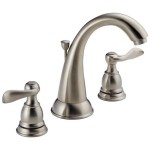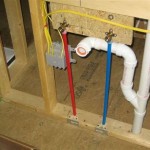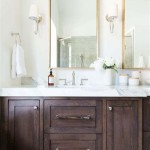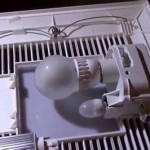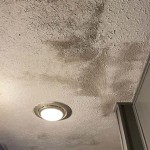How to Hide Pipes in the Bathroom
Exposed pipes in a bathroom can detract from the overall aesthetic and create a cluttered look. Fortunately, there are several effective methods to conceal these unsightly plumbing elements, enhancing the visual appeal and functionality of the space. This article will explore various techniques for hiding pipes in a bathroom, providing practical tips and considerations for seamless integration.
1. Enclose Pipes with Drywall or Paneling
One of the most common methods for hiding pipes is to enclose them with drywall or paneling. This involves building a framework around the pipes, securing it to the existing walls or ceiling, and then covering it with drywall or paneling. Drywall offers a smooth and easy-to-paint surface, while paneling provides a more rustic or contemporary look depending on the material chosen.
To begin, measure the area around the pipes to determine the required dimensions for the framing. Construct the frame using wood studs or metal channels, ensuring it is sturdy and securely fastened to the existing structure. After installing the framing, attach drywall or paneling to the frame, covering the pipes completely. Finally, apply joint compound, sand, and paint the drywall to match the surrounding walls.
This method is effective for concealing pipes located behind sinks, toilets, or bathtubs. However, ensure the enclosure has sufficient ventilation to prevent moisture buildup and potential mold growth. Regularly inspect the enclosure for leaks or any sign of damage, especially in areas prone to condensation.
2. Utilize Decorative Elements
Decorative elements can effectively disguise exposed pipes while adding visual interest to the bathroom. Consider using cabinet doors or shelves to conceal pipes behind sinks or tubs. Opt for cabinets with closed doors or shelves that offer ample storage space while hiding the pipes from view.
Another approach is to incorporate decorative moldings or trim around the pipes. This technique creates a visually appealing border that draws attention away from the pipes. Choose moldings that complement the bathroom’s style and color scheme. Install them carefully, ensuring a tight fit to create a seamless transition.
Lastly, consider using wall-mounted mirrors to strategically reflect light and divert attention from the pipes behind. Strategically placed mirrors can create an illusion of space and hide pipes behind them. Remember to choose mirrors that complement the bathroom's style and design.
3. Incorporate a Shower or Tub Surround
If the exposed pipes are located in the shower or bathtub area, consider incorporating a shower or tub surround. These enclosures provide a stylish and functional solution for concealing pipes while creating a more cohesive look.
Shower surrounds can be made from various materials like tile, acrylic, or fiberglass. Choose a surround that complements the existing bathroom decor and offers sufficient water resistance. Ensure the enclosure is properly sealed and secured to prevent leaks or water damage.
Tub surrounds can be constructed using similar materials to shower surrounds. Opt for a surround that extends to the ceiling, creating a seamless transition and concealing the pipes from view. Consider adding decorative accents like wainscoting or molding to enhance the aesthetic appeal of the surround.
4. Install a False Wall or Ceiling
In situations where pipes are located in awkward positions or require extensive concealment, a false wall or ceiling can be a solution. This involves building a separate structure over the existing wall or ceiling, concealing the pipes within the newly created space.
False walls can be constructed using drywall, paneling, or other building materials. Create a framework using wood studs or metal channels, ensuring it is sufficiently sturdy and anchored to the existing structure. Install the chosen material over the framework, ensuring a seamless transition with the original wall.
Similarly, false ceilings can be constructed using drywall or acoustic panels. The pipes can be hidden within the space between the false ceiling and the original ceiling. Ensure the false ceiling is properly supported, especially in areas with heavy pipes or appliances.
5. Relocate Pipes with Professional Assistance
In some cases, concealing pipes may not be the most practical solution. If the pipes are located in a highly visible area, are causing structural issues, or require regular access, relocating them might be the best option. This process typically requires the expertise of a licensed plumber or contractor.
Relocating pipes involves rerouting them through different pathways, often requiring adjustments to the existing plumbing system. This can involve cutting into walls, ceilings, or floors, requiring significant planning and expertise. Consult with a professional to assess the feasibility and costs involved in relocating the pipes.
6. Use Pipe Covers
Pipe covers are a simple and affordable option for concealing pipes. They come in various materials, colors, and designs, allowing you to find a style that complements your bathroom. They are typically made of plastic, metal, or wood and are designed to fit snugly around the pipes.
To install pipe covers, simply measure the pipes, choose the appropriate size cover, and attach it to the pipes. Some covers come with adhesive backing, while others require screws or clips for installation. Make sure the covers are secure and won't easily come loose.
Pipe covers are a good option for concealing pipes in small areas where other methods might not be feasible. They are also a good choice if you want to hide pipes without making major renovations to your bathroom.
When choosing pipe covers, consider the materials, color, and design to ensure they blend in with the rest of the bathroom. You can find covers that match the color of your walls or pipes, or choose a contrasting color to add a pop of interest.

How To Hide Plumbing In Your Bathroom Victoriaplum Com

An Interview With A Master Plumber And 3 Creative Ways To Hide Exposed Pipes Nir Plumbing

Creative Ways To Hide Exposed Plumbing Pipework Mayne Gas Heating

12 Best Hide Pipes Ideas Boxing In Small Toilet

Help Hiding Pipes In Downstairs Toilet Houzz

Boxing In Bathroom Pipework Guru

How To Hide Pipes On A Small Floating Si Bunnings Work Community

How To Cover Pipes In A Bathroom Dans Le Lakehouse

Cover And Tile Internal Soil Pipe When Fitting A Bathroom

How To Hide Plumbing Pipes In Your Bathroom Big
Related Posts


